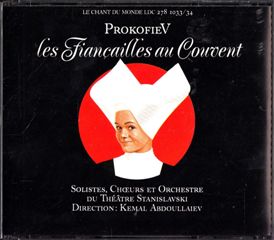Prokofiev - Les Fiancailles Au Couvent (Betrothal in a Monastery) [1960/1990]
Prokofiev - Les Fiancailles Au Couvent (Betrothal in a Monastery) [1960/1990]

Disc 1 1 – 9 Acte I 10 – 23 Acte II (Debut) Disc 2 1 – 2 Acte II (Fin) 4 – 13 Acte III 14 – 23 Acte IV Don Jérôme - Nicolas Korchounov : Ténor Ferdinand - Jan Kratov : Baryton Louisa - Valentina Kaievtchenka : Soprano La Duègne - Tamara Ianko : Contralto Clara - Nina Issakova : Mezzo-soprano Antonio - Anatoly Mistchevski : Ténor Mendoza - Edouard Boulavine : Basse Don Carlos/Père Chartreuse - Serge Illinski : Basse Père Augustin - Ivan Petrov: Basse Choeurs et Orchestre du Theatre Stanislavsky Kemal Abdoullaiev : Direction, Chef d'orchestre Les fiançailles au couvent (Betrothal in a monastery), opéra lyrico-comique en 4 actes op.86
Prokofiev’s musical production is heavily indebted to his encounter with Britain’s literary heritage, with such important works as his ballet Romeo and Juliet after Shakespeare and his four-act opera buffa Betrothal in a Monastery after Richard Brinsley Sheridan’s The Duenna or The Double Elopement. Written almost at the same time, the two works indicate the composer’s fascination for a different cultural heritage, so far unexploited in his operas inspired by the works of Russian or Italian writers. Betrothal in a Monastery is particularly arresting as it is based on a libretto to be set to music which Prokofiev immediately saw turned into an opera in the style of Mozart or Rossini. What were the composer’s intentions in writing his opera? What drove him to do so in the political context of the time? How does his interpretation, which revives the tradition of opera buffa, compare with Sheridan’s libretto and what personal viewpoint did he adopt? How did the composer use the original text to elaborate his own dramatic construction and develop his own brand of musical and melodic lyricism? These are the questions raised by his opera. ---lisa.revues.org
Based on the comedy The Duenna by British dramatist Richard Brinsley Sheridan (1751 - 1816) and featuring a libretto by Prokofiev's second wife, Mira Mendelssohn, this work was the composer's attempt to adapt Italian opera buffa to the Russian stage. The final product -- full of sparkling themes, brilliant vocal writing and fine comedic moments -- is a masterpiece fit to stand with his other comic effort, the delightful The Love for Three Oranges (1919).
Set in eighteenth-century Seville, the story of Betrothal in a Monastery deals with Louisa, whose father, Don Jerome, wants to marry her off to the wealthy Mendoza. However, she is in love with Antonio, and her nanny is in love Mendoza. The nanny, or Duenna, devises a scheme so that both can marry the man of their choice; disguises, mistaken identities, and other stock opera buffa plot gestures all lead to a happy ending for the lovers.
Prokofiev consciously modeled the style of the work on the comic operas of Mozart and Rossini; their imprint can be heard in several numbers such as the brilliant Act III quartet involving Louisa (soprano), Don Carlos (tenor), Mendoza (bass), and Antonio (tenor). While certain comparisons can be made between this opera and Prokofiev's The Love for Three Oranges, they are substantially different works, the latter effort being far more lyrical.
Louisa and Antonio's love theme, first introduced in the fourth scene of Act I, is one of the most famous in the work. It is a long-breathed soaring melody that reaches its greatest flowering in the duet between the two in Act III (scene 1, seventh tableau). Oddly, when Prokofiev fashioned a suite from this opera, called Summer Night, Op. 123 (1950), he lightened this melody and gave it a more playful manner.
Much of the music in the opera is light and playful. In the opening scene of the first act, Prokofiev deftly fashions music for the fish merchant Mendoza that imitates the swimming manner of fish. Also, there is a humorous woodwind theme, usually punctuated by percussive "thwacks," that appears several times throughout the opera. It is actually taken up vocally by Don Jerome -- the one character it seems to describe -- at the opening of the sixth tableau in the third act.
Other notable themes from the opera include the brass theme from the brief orchestral introduction, and the obsessive, rhythmic dance theme first appearing in Act I, scene 7; it returns for the wild ending, where the music builds and builds, then explodes to the shouts of the chorus. --- Robert Cummings, Rovi
download (mp3 @320 kbs):
oboom yandex 4shared mega mediafire zalivalka cloudmailru uplea








